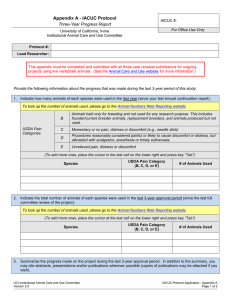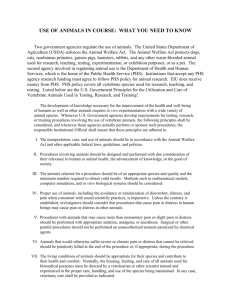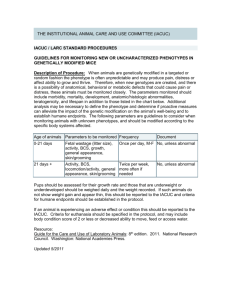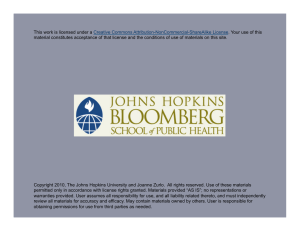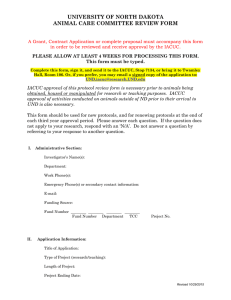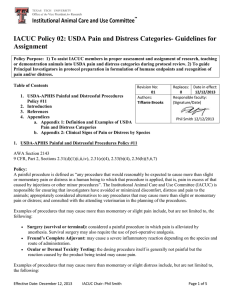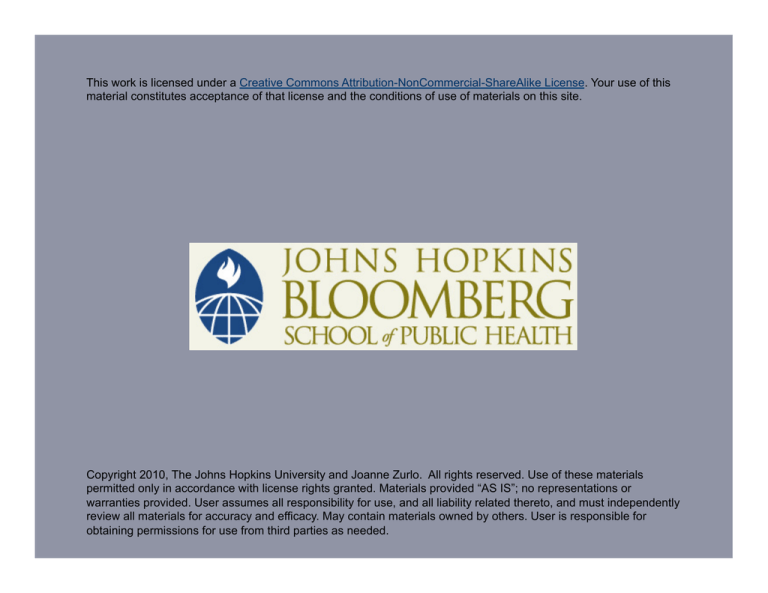
This work is licensed under a Creative Commons Attribution-NonCommercial-ShareAlike License. Your use of this
material constitutes acceptance of that license and the conditions of use of materials on this site.
Copyright 2010, The Johns Hopkins University and Joanne Zurlo. All rights reserved. Use of these materials
permitted only in accordance with license rights granted. Materials provided “AS IS”; no representations or
warranties provided. User assumes all responsibility for use, and all liability related thereto, and must independently
review all materials for accuracy and efficacy. May contain materials owned by others. User is responsible for
obtaining permissions for use from third parties as needed.
Section B
More Considerations and Proposed Activities
USDA Policy 11
Procedures involving animals will avoid or minimize discomfort,
distress, and/or pain
A painful procedure is defined as any procedure that would
reasonably be expected to cause more than slight or momentary
pain and/or distress in a human being
3
USDA Pain Categories
Category C—no pain, distress, or use of pain-relieving drugs
Category D—accompanying pain or distress for which appropriate
anesthetic, analgesic, or tranquilizing drugs are used
Category E—accompanying pain or distress for which use of drugs
would adversely affect research outcome
4
USDA Policy 12
Principal investigators must consider alternatives (reduction,
refinement, or replacement) to procedures that may cause more
than momentary or slight pain or distress to the animals and provide
a written narrative of methods used and sources consulted
5
When Does an Alternative Search Need to Be Done?
An alternative search must be done for any procedure that causes
more than momentary pain or distress (either relieved or
unrelieved) (Categories D and E)
6
Written Narrative for Alternatives
Written narratives for alternatives to painful procedures must
include the following:
- Databases searched or other sources used
- Date of search
- Years covered by the search
- Key words used/search strategy
7
More Refinement Considerations: Humane Endpoints
Humane endpoints—euthanizing an animal prior to death in order to
minimize pain and/or distress while preserving the scientific
integrity of the study
8
More Refinement Considerations: Humane Endpoints
Humane endpoints—common scenarios where they may be
considered
- Tumor biology or carcinogenesis studies
- Genetically modified animal models
- Infectious disease studies
- Toxicity testing
9
Euthanasia Considerations
AVMA guidelines on euthanasia
- Minimum pain, distress, anxiety, or apprehension
- Minimum delay until unconsciousness
- Reliability and irreversibility
- Safety of personnel; emotional effect on personnel
- Compatibility with requirement and purpose
- Compatibility with species, age, and health status
- Drug availability and human abuse potential
10
Euthanasia Considerations—Acceptable Methods
Barbiturates (DEA-controlled)
Benzocaine HCl (fish, amphibians)
CO2 (bottled gas only)
CO (bottled gas only) (worker safety issues)
Inhalant anesthetics
Microwave irradiation (mice, rats)
11
Euthanasia Considerations—Acceptable Methods
Penetrating captive bolt (swine, horses, ruminants)
2-phenoxyethanol (fish)
Tricaine methanesulfonate (fish, amphibians)
KCl (intracardially or IV in conjunction with general anesthesia)
12
Euthanasia—Conditionally Acceptable Methods
Cervical dislocation (birds, small rodents, and rabbits)
Decapitation (rats, mice, birds)
Pithing (some ectotherms)
Some pharmacological agents in some species
13
Euthanasia Considerations—Unacceptable Methods
Air embolism
Chloroform, cyanide (danger to personnel)
Decompression
Neuromuscular blockers
Dry ice generated CO2
14
Other Relevant IACUC Topics
Agricultural research
Antibody production
Breeding colonies
Field studies
Hazardous materials
Instructional use of animals
Surgery
Genetically modified animals
15
Other Relevant IACUC Topics
Post approval monitoring
Retrospective reporting of adverse effects
Over-interpretation of regulations—the more is better principle
16
Handout
The handout is available from the Online Library section of the
lecture page
17
IACUC Training
IACUC 101/201 workshops
IACUC advanced workshops (Scientists Center for Animal Welfare—
SCAW)
Meeting the information requirements of the Animal Welfare Act
(Animal Welfare Information Center, USDA)
SCAW annual conference
Public Responsibility in Medicine and Research (PRIM&R) annual
IACUC conference
18
Some Internet Resources
Altweb (Johns Hopkins University)
- http://altweb.jhsph.edu/
Office of Laboratory Animal Welfare (NIH)
- http://grants.nih.gov/grants/olaw/olaw.htm
AAALAC International
- http://www.aaalac.org/
Animal Welfare Information Center (USDA)
-
http://awic.nal.usda.gov/nal_display/index.php?
info_center=3&tax_level=1
Institute for Laboratory Animal Research
- http://dels.nas.edu/ilar_n/ilarhome/
19
Some Internet Resources
Animal Welfare Act
- http://www.nal.usda.gov/awic/pubs/AWA2007/awa.shtml
IACUC.org
- http://www.iacuc.org/
Public Responsibility in Medicine and Research (PRIM&R)
- http://www.primr.org/
Scientists Center for Animal Welfare (SCAW)
-
http://www.scaw.com/
20


